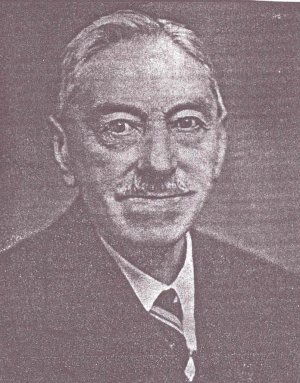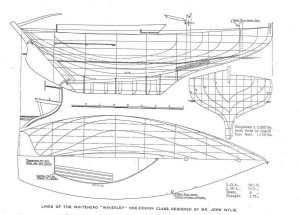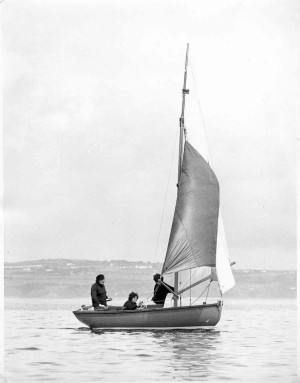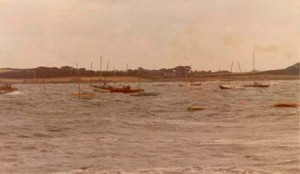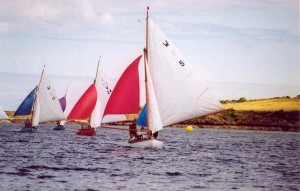The History of the Waverley Class
In the summer of 1903 three small yachts, “Rowena”, “Talisman” and “Red Gauntlet” sailed their first race off Whitehead. The Waverley Class was born. In each of the next five years another boat was added to the fleet so that by 1908 the class numbered eight. The Waverley, designed by John Wylie who was a member of County Antrim Yacht Club, had a class rule that the boats should take their names from characters in Sir Walter Scott’s Waverley novels.
At just over 18 feet and with a sail area of just of about 200 square feet plus a small spinnaker, these little keel-boats were perfect miniatures of the yachts of that time and seemed to be exactly suited to the sailing conditions in Belfast Lough. No original plans exist and it may well be that the first boats were built from lines taken from a half model: quite a normal practice until the beginning of the last century. They were also seen as attractive elsewhere. With very minor structural differences, a class of five boats was built for Strangford Lough where they were called Seabirds. After the First World War these boats all migrated to Belfast Lough where they were accepted into the class on condition that they were given Waverley names.
The Dancing Class of Royal Ulster Yacht Club was also built to John Wylie’s plans in the 1920s. The structural differences in this case were considered too great for them to be accepted as Waverleys until one of the two surviving Dancers was taken into the class in 1974, with of course an appropriate change of name!
By the end of World War 1 the Waverleys were no longer exclusive to County Antrim Yacht Club and in the early 1920s two further boats were built in Bangor. One of these, Peveril, was shortly to become the first victim of the class’s greatest enemy; wrecked on the beach in a storm.
That first loss did not dampen the enthusiasm for the class which was based on the boats’ sailing qualities and the extremely competitive racing that they provided. There have always been stories of “fast” boats but a glance at the prize lists over the years shows that just about all of them have had their moments of glory. They certainly engendered enormous rivalry amongst their owners and the minutes of the class meetings, which have been kept for most of the hundred years, suggest that some of that rivalry was brought ashore!
In the 1930s the great debate was centred around the rig of the boats. Several owners thought the original gunter rig old-fashioned and inefficient and eventually Mr Slater of Bangor Shipyard was invited to design an alternative bermudan sail-plan. Many of the boats changed to the taller rig and boats of both rigs competed effectively with each other until, after 40 years of the “experiment” all Waverley owners agreed to revert to the original rig. Otherwise the boats have remained very close to the original specifications, except for the introduction of synthetic materials for sails and rigging and jam cleats for main and jib sheets. No winches are allowed. There have been other minor changes, in 1961 the class agreed to drop the rule stating that the crew “should consist of three members, ladies not to count as members of crew”.
The Waverley class has not been free from disaster. After almost fifty years of safe sailing in Belfast Lough one boat returning to Whitehead from Ballyholme sank with the loss of four young men. Any keel-boat can sink if the weather is bad enough but this tragedy led to the temporary loss of confidence in the class. The reputation of a safe boat had been tremendously high and well deserved but the old notion of “what they won’t carry they’ll drag” was unrealistic. However the class survived and in the early sixties “Durward” not only sailed to England and France but also set the record for circumnavigating Ireland that was to stand for many years.
In 1961, when the class was reformed as a racing class at Ballyholme Yacht Club, Waverleys were to be found at most of the clubs in Belfast Lough. Growth of the class at Ballyholme Yacht Club was rapid and by the summer of 1974 thirteen boats were competing in class racing during the week and visiting regattas at the weekends.
Over the years several boats have been lost at moorings due to storm damage, particularly in the violent gales of 1976, when all but two of the twelve boats at moorings in Ballyholme Bay sank. Only two were beyond repair, Rowena and Dauntless. Between 1946 and 1980 three new boats have been built on the keels of boats wrecked in this way. The move from open moorings in Belfast Lough to Bangor Marina in 1990 has meant that the class’s greatest enemy has hopefully been overcome.
In 2003, after some lean years with few boats afloat, the class celebrated it’s centenary season with a week-end of racing and a dinner at Royal Ulster Yacht Club. A number of ex-owners were present at the dinner including visitors from Canada. The weather was kind, although the winds were on the light side, and eight boats (including Durward which is based in Dun Laoghaire) took part in a very enjoyable weekend’s racing.
Currently the class consists of thirteen boats not all of which are in seaworthy condition. Kenilworth has been donated to the Ulster Folk and Transport Museum by the Hay family, Rob Roy has been laid up for the past decade, Fair Maid is undergoing extensive renovations and Rebecca, which was wrecked at Whitehead in 2002, is about to be rebuilt by John Davey of Bangor. So after over one hundred years of competitive racing the class is still going strong and in this highly technological age Waverley owners are of the opinion that there isn’t a boat to touch these beautiful, hardy, classic craft, if it is tight and energetic sailing that is being looked for.
